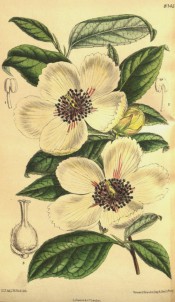Stewartia malacodendron L.
Somewhat tender shrub or small tree with alternate. Toothed leaves and axillary white flowers with purple stamens. To 4m. [RHSD, Hortus].
Horticultural & Botanical History
Introduced to Britain in 1741. ‘There are three species of Stewartia, namely, S. Pseudo-camellia, Maxim. (B.M. t.7045), from Japan; S. pentagyna, L’Her. (B.M. t.3918), North America, and the one here figured, which is better known under the name of S. virginica, Cav. Mark Catesby, in his monumental work cited above, says of this shrub: “For this elegant plant I am obliged to my good friend, Mr. Clayton, who sent it to me from Virginia, and three months after its arrival it blossomed in my garden at Fulham in May, 1742.” […] This very ornamental shrub has never got into general cultivation in British gardens, perhaps partly on account of its not flourishing in ordinary garden soil, and partly because it does not usually flower freely until it has attained a considerable size. Catesby does not say anything about the size of his plant, which flowered three months after it reached England; but it may be assumed that it was quite small. Philip Miller also mentions its having flowered before 1756, in Mr. Christopher Gray’s nursery garden at Fulham; and there are some recent records of its having flowered profusely, notably at Syon House. The drawing for the accompanying plate was made from specimens communicated by Sir Joseph Hooker, in whose garden at Sunningdale it flowered freely last year.’ [BM t.8145/1907].
History at Camden Park
Desideratum to Loddiges’ Nursery, 6th January 1845 [MP A2933-2, p.28]. This is the only record and it may not have been grown in the gardens.
Notes
Published Mar 31, 2010 - 11:27 AM | Last updated Mar 31, 2010 - 11:38 AM
| Family | Theaceae |
|---|---|
| Category | |
| Region of origin | North America |
| Synonyms |
|
| Common Name | Silky camellia, Silky Stewartia |
| Name in the Camden Park Record |
Stuartia malacodendron |
| Confidence level | high |


